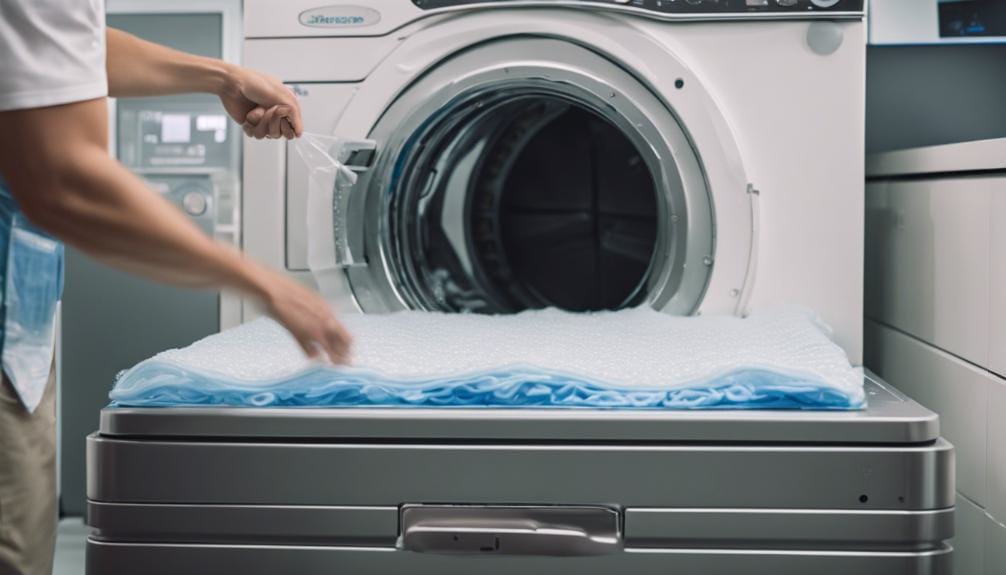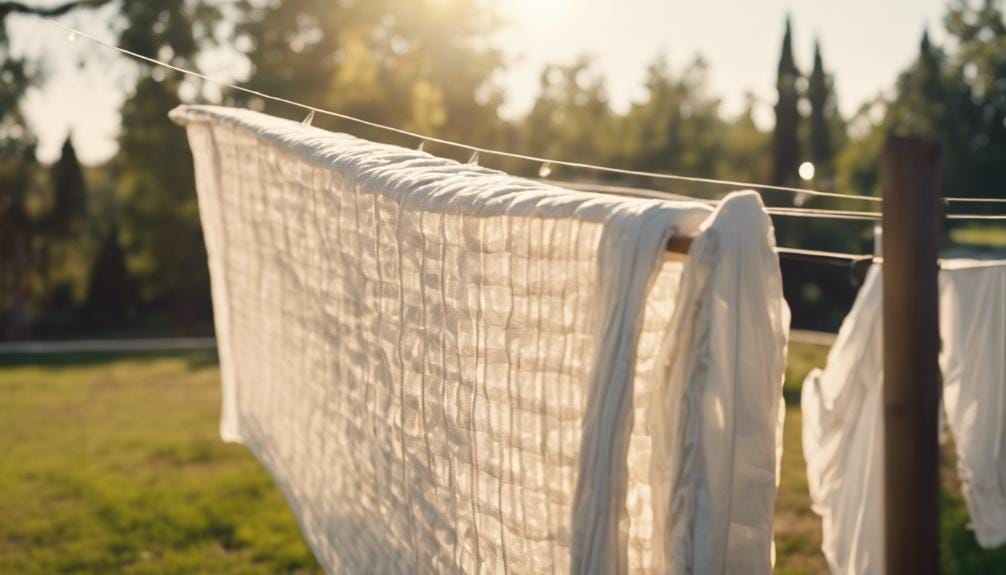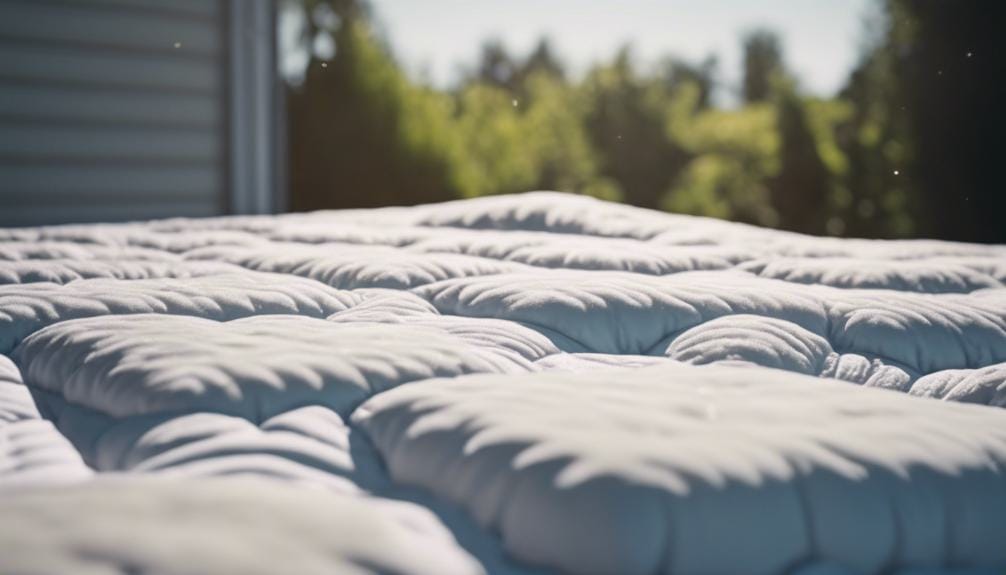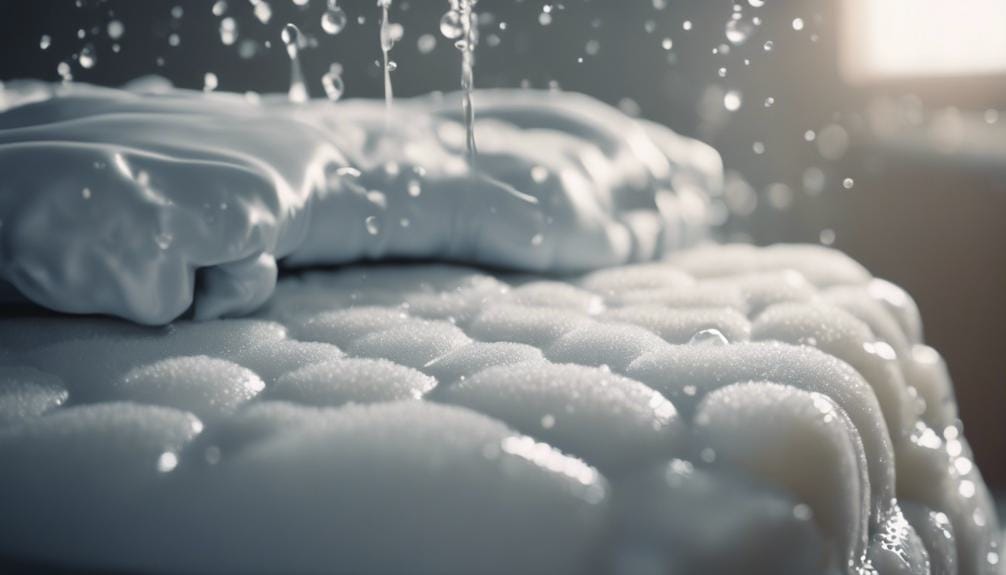Can Mattress Toppers Be Washed? A Guide to Cleaning Your Topper
Yes, you can wash certain types of mattress toppers to keep them clean. Memory foam toppers should be spot cleaned, while cotton toppers can usually be machine washed. Always check the care label for specific instructions. Washing every three months helps maintain freshness. For stains, use mild detergent and avoid over-soaking. Air drying is best to prevent mold. If you’re unsure about washing your topper, more tips on cleaning methods and extending its lifespan are available.
Types of Mattress Toppers
When selecting a mattress topper, it’s important to know the different types available. Gel mattress toppers keep you cool while sleeping but cost more.
Don’t machine wash memory foam toppers, as it can cause damage. Cotton toppers, on the other hand, are usually safe to machine wash.
Materials like wool, latex, and bamboo require specific care; always check the care label for instructions. This straightforward approach helps you choose the right topper for your comfort and budget needs without confusion.
Cleaning Frequency for Toppers
To keep your mattress topper in top condition and extend its lifespan, it’s advisable to wash it every three months. Here’s how you can effectively maintain its cleanliness:
- Spot clean spills promptly to avoid stains. When a spill occurs, cleaning it immediately can prevent the liquid from seeping deep into the fibers, making stain removal easier.
- Have a routine for stain removal to reduce the need for frequent washes. Regularly checking and treating any spots or stains can maintain the cleanliness of your topper without constant washing, which can wear it down.
- Deep clean your mattress topper when necessary. If you notice an odor or if the topper hasn’t been cleaned in a while, a thorough wash might be needed to refresh it.
- Adjust the washing frequency based on how often it’s used and if you have allergies. More frequent cleaning might be required if the topper is used daily or if someone using the bed has allergies to dust or mites.
Washing Machine Suitability for Toppers

Check the care label before cleaning your mattress topper. Not all toppers are suitable for machine washing. Foam types, like memory foam, need spot cleaning because they absorb water and can get damaged in a washing machine.
On the other hand, thin featherbed, polyester, or cotton toppers can often be machine washed. Always follow the care instructions that come with your topper. This practice helps keep it clean and extends its life.
Spot Cleaning Techniques for Toppers
For effective spot cleaning of your mattress topper, opt for a mild detergent such as laundry detergent or dish soap to tackle stains.
- Avoid over-soaking: Prevent excessive moisture. Excessive moisture can seep deep into the topper, promoting mold and mildew growth.
- Dab the stained area: Gently press with a light-colored cloth. Rubbing can spread the stain wider or embed it deeper.
- Vinegar solution: Effective for tough stains. A solution of equal parts water and vinegar helps break down stains without damaging fabric fibers.
- Baking soda solution: Useful for deep cleaning. Sprinkle baking soda on the area, let it sit for a few hours, and then vacuum it up to absorb odors and light stains.
Remember to test any cleaner on a small, inconspicuous area first to ensure it doesn’t discolor the fabric. Dry the topper thoroughly in a well-ventilated area to prevent moisture buildup.
Drying Methods for Toppers

To effectively dry your mattress topper after cleaning, air drying is highly recommended. This method helps prevent the growth of mold and mildew. If there are still damp spots, you can use a hair dryer on a low setting. Ensure the topper is entirely dry, as lingering moisture can lead to problems.
However, remember that too much heat can damage foam toppers, so it’s best to stick with air drying. Allow your topper to air dry for a full day to make sure it is completely dry and to prevent any mold from developing.
| Drying Method | Benefits |
|---|---|
| Air Drying | Prevents mold growth |
| Hair Dryer | Effective for damp spots |
This approach not only maintains the quality of your topper but also extends its lifespan by avoiding heat damage.
Proper Stain Removal for Toppers
To keep your mattress topper clean and fresh, tackle stains immediately. Here’s a practical guide:
- Spot clean stains right away to stop them from setting in.
- Mix a mild detergent with water and gently dab the stain.
- Avoid using harsh chemicals or bleach, as these can damage the fabric.
- Blot the stain with a light-colored cloth to soak up as much as possible.
This method helps maintain the quality and appearance of your topper without using strong chemicals that might harm the material.
Extending Topper Lifespan Tips

To extend the life of your mattress topper, regular cleaning and protective steps are crucial. Follow the care instructions for proper washing and drying. Use a mattress protector to shield against water damage and stains. Wash your fitted sheets often to keep allergens at bay. These steps will help you maintain your mattress topper in good condition, making your investment last longer.
Remember to check the manufacturer’s guidelines before cleaning your topper. Some materials may require specific care. Use gentle detergents and avoid harsh chemicals that can break down the fabric. If your topper isn’t machine washable, consider spot cleaning or professional cleaning services.
Protecting your mattress topper also involves using a good quality mattress protector. These protectors act as a barrier against moisture, dust, and other potential contaminants. They’re usually waterproof and can be washed regularly, which helps maintain a clean sleeping environment.
Washing your sheets regularly is another effective way to prolong the life of your mattress topper. Dust mites, sweat, and skin cells can accumulate quickly. By keeping your bedding clean, you reduce the amount of dirt and allergens that reach your topper. Aim to wash your sheets every one to two weeks.
Signs to Replace a Topper
If you spot depressions, sagging, or flattened foam on your mattress topper, it might be time to consider getting a new one.
- Persistent odors or smells that won’t go away even after cleaning suggest a need for replacement.
- Holes or tears that can’t be fixed are clear signs that you need a new topper.
- If your topper resists cleaning efforts, it likely harbors deep-seated dirt or stains.
- Excessive wear and tear that leads to a sagging or flattened topper also indicates it’s time for a change.
Value of Washing a Topper

Washing your mattress topper is crucial for maintaining cleanliness and health. It removes dust mites, allergens, and bacteria, which can harm your health. Regular cleaning helps you sleep better and keeps the topper in good condition for longer.
| Value of Washing a Mattress Topper | ||
|---|---|---|
| Benefit | Description | Effect |
| Removes Dust Mites | Keeps the sleeping area allergen-free | Enhances sleep quality |
| Clears Allergens | Lowers the risk of respiratory problems | Improves health |
| Destroys Bacteria | Ensures a clean sleeping environment | Extends topper’s life |
Remember to follow the manufacturer’s instructions on how often to wash your topper. This preserves its comfort and effectiveness. Use proper washing techniques to avoid damaging the topper. By maintaining a clean mattress topper, you contribute to a healthier sleep environment and improved overall well-being.
Frequently Asked Questions
Can Mattress Topper Be Washed in Washing Machine?
To determine if your mattress topper can be washed in a washing machine, check the care label instructions. Foam toppers like memory foam are usually not machine washable. Thin featherbed, polyester, or cotton toppers might be suitable for machine washing with the right detergent. Remember to spot clean spills first.
How Do You Clean a Mattress Topper?
To clean a mattress topper, spot clean spills promptly, vacuum regularly, and use mild solutions like baking soda and water for stains. Air dry thoroughly before putting it back on the bed to prevent mold growth.
Can You Put a Foam Mattress Topper in the Dryer?
To guarantee your foam mattress topper stays in good shape, avoid putting it in the dryer. Heat can harm the foam. Check care labels for suitable drying methods. Air-drying is best to maintain quality. Always follow care instructions.
How Often Should You Wash a Mattress Topper?
You should wash a mattress topper every 3 months to maintain cleanliness and hygiene. Regular washing prevents dust mites, allergens, and bacteria buildup, ensuring peak sleep quality. It’s important to wash it regularly for freshness and to remove contaminants affecting sleep.
Conclusion
Can you wash mattress toppers?
Yes, you can. It’s important to clean your mattress topper regularly to keep it in good shape and make it last longer.
You can either spot clean or machine wash it, depending on the care instructions. Make sure to use the right cleaning methods and dry it properly.
This will ensure your topper stays fresh and comfortable, helping you get a good night’s sleep.
